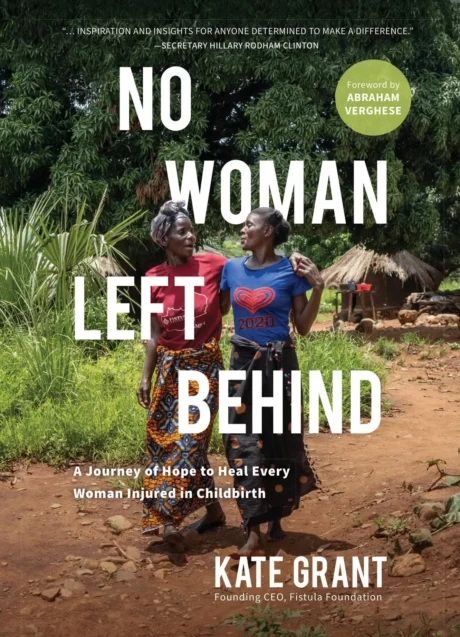Today, at least one million women in Africa and Asia needlessly suffer from untreated fistula.
How Fistula Occurs
During her prolonged labor, the mother’s contractions continually push the baby’s head against her pelvis. Soft tissues caught between the baby’s head and her pelvic bone become compressed, restricting the normal flow of blood.
Without adequate blood supply, sections of tissue soon die, leaving holes—known as “fistulae” —between the mother’s vagina and her bladder or rectum. It is these holes that cause incontinence. If untreated, the woman will uncontrollably leak urine, stool, or sometimes both, for the rest of her life.
Severe perineal tears: A growing need in the field
Severe perineal tears are another debilitating injury that can occur when a woman in labor does not have access to adequate care. The effects of this injury—a tearing to the anal sphincter muscle—leaves a woman incontinent of feces. In recent years, as our partners’ outreach workers have found women with fistula, they’ve increasingly encountered women with this similarly debilitating childbirth injury. Perineal tears now account for approximately 20% of the women we treat.
Learn more about our approach to treatment
How Untreated Fistula Impacts a Woman’s Life
Untreated obstetric fistula most commonly occurs in poor, rural areas of Africa and Asia where the women affected live in dirt-floor dwellings and lack access to running water and incontinence pads.
Under these circumstances, a woman with a fistula or a severe tear faces devastating physical and psychological consequences. Unable to control the leaking of her body’s waste, she suffers with chronic infections and pain. Too often, her smell drives away her husband, family and friends.
With little community understanding of her injury and its causes, a woman is frequently blamed for her condition. She too often lives in isolation, unaware that others share her injury and that it is treatable. If the fistula or severe tear occurs during a woman’s first pregnancy—when she is in her teens or early twenties—she will suffer for decades, if it is not repaired.
Yes. Corrective surgery provides effective treatment for women suffering from an obstetric fistula or a severe perineal tear. If the operation is performed by a skilled surgeon, a woman with either of these childbirth injuries can very often return to a normal life, with her continence and hope restored.
Fistula commonly occurs to women in their early twenties, in countries where the average life span is approximately 65 years—meaning a one-time surgical intervention can restore 40+ years of health.
Even though obstructed labor occurs in approximately 5% of all child births worldwide, obstetric fistula has largely been eradicated in wealthy countries, thanks to the advent of the Cesarean section in the early 1900s.
Today, fistula persists in low-income countries where women have limited access to emergency obstetric care. It continues to destroy women’s lives at an alarming rate in poor, rural regions of Africa and Asia, where fewer than 6 out of 10 women give birth with a medical professional present.
Perineal tears commonly occur during vaginal childbirth around the world. Small tears can heal on their own with proper management. Because women in wealthy countries usually give birth at a health facility, a severe tear can either be prevented or can immediately be diagnosed and treated. It is unlikely a woman in a wealthy country would live with an untreated tear.
An obstetric fistula occurs when a mother has a prolonged, obstructed labor, but cannot access emergency medical care, such as a C-section. It is a symptom of deep, intractable poverty and the low status of women and girls.
In poor countries, many children are malnourished, which can stunt their growth. If a young mother’s pelvis is not fully mature, she is at an increased risk of experiencing an obstructed labor—and with it, devastating childbirth injuries like obstetric fistula. The practice of early marriage and young pregnancy can additionally compound this risk.
Another cause of fistula is a critical lack of doctors and medical facilities. In poor, rural regions of Africa and Asia, fewer than 6 out of 10 women give birth with a medical professional present.
Why Are Women Still Suffering?
Women in Africa and Asia are needlessly suffering today for want of a single surgery that can completely transform their lives.
Fistula repair surgery was a common practice in wealthy, western nations in the late 1800s. With the advent of C-sections, fistula has been largely eradicated from wealthy countries. While perineal tears still commonly occur in wealthy nations, prevention and treatment are readily available and women rarely suffer at home.
Living in rural parts of Africa and Asia, women with untreated fistula or severe perineal tears are some of the world’s most vulnerable individuals. Fistula Foundation exists to remove all barriers to treatment so that every woman can have access to high-quality care.
Learn about barriers to treatment
Dr. Denis MukwegeTaking action means saying 'no' to indifference...It is a choice: whether or not to support a woman, whether or not to protect her, whether or not to defend her rights.
What is Obstetric Fistula?
Fistula Foundation works to end the suffering caused by devastating childbirth injuries, because we believe no woman should endure a life of misery simply for trying to bring a child into the world.


